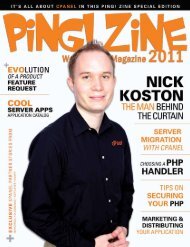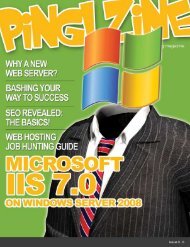bits & bytes - Ping! Zine Web Tech Magazine
bits & bytes - Ping! Zine Web Tech Magazine
bits & bytes - Ping! Zine Web Tech Magazine
You also want an ePaper? Increase the reach of your titles
YUMPU automatically turns print PDFs into web optimized ePapers that Google loves.
SERVER SECURITY<br />
Making the Right Choice<br />
of Identity and Trust Assurance (ITA)<br />
Infrastructure Can Boost E-commerce<br />
by Steve Roylance<br />
As the Internet continues to expand, so do the challenges<br />
for new e-business brands wishing to differentiate<br />
themselves from a multitude of “similar” providers, all<br />
of whom are vying for a share of increased online business. With<br />
a plethora of experts offering new and innovative ways of driving<br />
additional traffic to emergent sites, and with the simplicity of<br />
advertising campaigns such as Google Adwords, in most cases<br />
“traffic generation” is not the biggest problem. “Conversion”<br />
– taking a visitor and turning them into a customer – is one of<br />
the most important hurdles that new e-business brands must<br />
overcome.<br />
Optimizing conversion in website traffic is a direct function of<br />
managing consumer trust. The higher the consumer trusts a site, the<br />
higher the conversion rates for that site. Well-established brands<br />
rely heavily on their brand integrity, improved service levels<br />
and expanded offerings to entice business from new consumers.<br />
Larger brands therefore have effectively translated the internet<br />
“web trust” model into a revenue-generating strategy.<br />
However, “unknown brands” are at a significant “trust”<br />
disadvantage, and they experience tremendous pressure to<br />
differentiate themselves to survive. With no means to compete<br />
directly with stronger, more established brands, new brands<br />
are forced to focus on two alternative methods to grow market<br />
share. The first, and rather more risky strategy, entails providing<br />
higher and higher discount levels. By its very nature, it minimizes<br />
margins and profitability, and more often than not, results in a far<br />
greater failure rate. The alternative method relies on maximizing<br />
the use of an ITA (Identity and Trust Assurance) infrastructure.<br />
This method yields a far higher rate of return on investment, and<br />
more importantly, it proves to be highly effective at building<br />
loyalty in a shorter time frame.<br />
So, what is Identity and Trust Assurance and why does it<br />
succeed when compared to the alternative choice of offering<br />
lower prices? For example, consider two competing restaurants,<br />
both offering a similar selection of foods. If the higher-priced<br />
restaurant actually has customers sitting down and eating, this<br />
offers a far more powerful influence to potential new consumers<br />
than the restaurant with lower prices. This clearly indicates how<br />
trust and assurance can be more persuasive than price, and is one<br />
of the reasons why many websites offer case studies (i.e. people<br />
already eating) to provide reassurance to new customers. Even<br />
more powerful tools and techniques to provide trust and assurance<br />
should also be implemented, right across the website, to provide<br />
consumers with recognized trust credentials that can help them<br />
manage their risk. Some examples of these technologies include<br />
high assurance SSL certificates – or a web seal to assure customers<br />
that the site is “Hacker Proof.”<br />
How Trusted <strong>Tech</strong>nologies Work<br />
To date, one of the key reasons for the growth of the Internet<br />
as an e-commerce engine has been the widespread deployment<br />
of security technologies implemented within browsers and web<br />
38 <strong>Ping</strong>! <strong>Zine</strong> <strong>Web</strong> Hosting <strong>Magazine</strong>
















